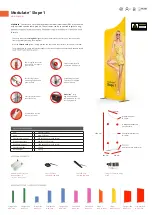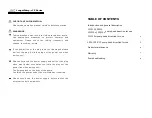
AirWave System Operator’s Manual
4
D. Principles of Operation
The AirWave System
The SonarMed AirWave Monitoring System, as shown in Figure D-1, consists of an AirWave Sensor connected to
the proximal end of an ETT, and a Monitor to which the Sensor is connected via a cable.
Inside the AirWave Sensor are embedded a miniature speaker, for emitting sound waves into the ETT, and
microphones, for sensing the returning acoustic echoes. The amplitudes and timing of the echoes are analyzed
by the Monitor to provide the following information:
•
location and size of ETT obstructions
•
size of the passageway around the ETT tip
•
relative movements of the ETT tip within the trachea
Figure D-1
SonarMed AirWave System
During use of the AirWave, an option is provided via the
Patient Monitoring Waveform Screen
to view the echo
signal to provide a means to the user to verify that the signal is free of artifact and that the algorithm is properly
identifying and tracking the ETT and the patient’s airway echoes. This primer is intended to help the user to
better understand and interpret the AirWave echo signals.
Acoustic Reflectometry
The SonarMed AirWave employs the technique of acoustic reflectometry which consists of emitting acoustic
waves into an unknown object (or in this case, an intubated ETT), detecting the returning acoustic reflections
(echoes), and examining their timing and amplitudes to infer characteristics of the object in question.
As mentioned above, the AirWave Sensor contains a speaker, for generating acoustic waves which travel into the
ETT and airways, and two microphones (separated by a small distance), for converting the reflected waves into
an echo signal which is input into the Monitor’s proprietary algorithms. This echo signal consists of positive and
negative deflections that represent positive and negative sound pressure waves, respectively.
The use of two microphones to sense the acoustic waves allows the system to determine the direction from which
echoes arrive. As a result, the system can selectively filter all echoes that arise from devices on the ventilator
side of the Sensor, such as closed-circuit suction catheters, y-connectors, ETCO
2
sensors, filters, etc. This
selective filtering is critical for obtaining a clean echo waveform from the ETT and airways that is free of ventilator
circuit echoes.









































